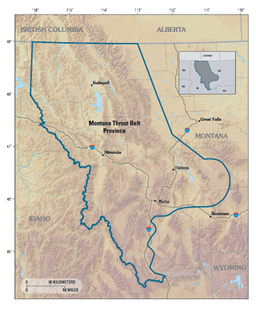| Using a geology-based assessment methodology, the U.S. Geological Survey estimated a mean of 8.6 trillion cubic feet of undiscovered natural gas, a mean of 109 million barrels of undiscovered oil, and a mean of 240 million barrels of natural gas liquids in the Montana Thrust Belt Province of northwestern Montana. |
| Introduction |
| The U.S. Geological Survey (USGS) recently completed an assessment of the undiscovered oil and gas potential of the Montana Thrust Belt Province of northwestern Montana (fig. 1). The assessment of the Montana Thrust Belt Province is based on the geologic elements of each Total Petroleum System defi ned in the province, including hydrocarbon source rocks (source-rock maturation, hydrocarbon generation and migration), reservoir rocks (sequence stratigraphy and petrophysical properties), and hydrocarbon traps (trap formation and timing). Using this geologic framework, the USGS defined seven Total Petroleum Systems (TPS) and nine Assessment Units within these Total Petroleum Systems and quantitatively estimated the undiscovered oil and gas resources within seven of the nine Assessment Units (table 1). |
| Resource Summary |
| The USGS assessed undiscovered conventional oil and gas and continuous (unconventional) oil. The USGS estimated a mean of 8.6 trillion cubic feet of gas (TCFG), a mean of 109 million barrels of oil (MMBO), and a mean of 240 million barrels of total natural gas liquids (MMBNGL) in fi ve Total Petroleum Systems. Nearly all (99 percent) of the undiscovered gas resource is conventional, whereas about 75 percent of the undiscovered oil resource is conventional (table 1). Of the 8.6 TCFG, about 7.7 TCFG is estimated to be in the Paleozoic/Mesozoic Composite Total Petroleum System of the Thrust Belt, and 0.68 TCFG is in the Central Montana Trough Paleozoic Composite Total Petroleum System of the Helena Salient. The remainder of the gas (about 0.28 TCFG) is associated/dissolved gas in oil accumulations (table 1). Because the USGS assessment of natural gas is for total gas, the conventional gas in these TPSs may contain signifi cant percentages of gases other than hydrocarbon gases, such as carbon dioxide. The Tertiary Lacustrine Shale Total Petroleum System is estimated to contain a mean of about 69 MMB of conventional oil, whereas the Marias River Shale Total Petroleum System is estimated to contain about 28 MMB of continuous (unconventional) oil. The Bakken Formation and Jurassic/Cretaceous Total Petroleum Systems were not quantitatively assessed in this study. |
| For Further Information |
| Supporting geologic studies of Total Petroleum Systems and Assessment
Units, and reports on the methodology used in the Montana Thrust Belt
Province assessment, are in progress. Assessment results are available at the USGS Central Energy Team website: http://energy.cr.usgs.gov/oilgas/noga/ |
Figure 1. Montana Thrust Belt Province of northwestern Montana.
| Montana Thrust Belt Assessment Team: |
| Christopher J. Schenk (Task Leader; schenk@usgs.gov), Ronald R. Charpentier, Troy A. Cook, Thaddeus S. Dyman, Christopher D. French, Mitchell E. Henry, Timothy R. Klett, William J. Perry, Richard M. Pollastro, and Christopher J. Potter. |
